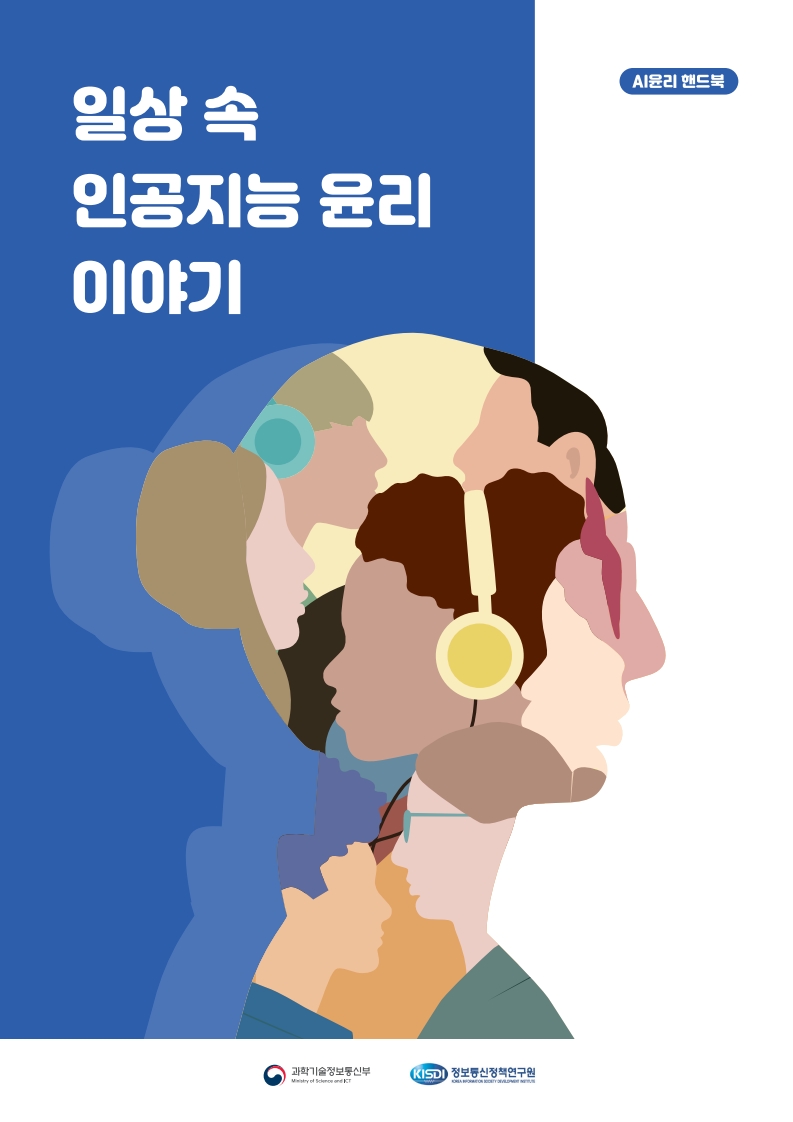AI Ethics Textbook: AI Ethics in Our Daily Lives
1. Introduction
AI technology is becoming an integral part of our daily lives, embedded in the digital devices and services we use every day. Often, we interact with AI without realizing it, or if we do, we may not fully understand how it works or the risks it might pose.
This is why it’s crucial to learn about these risks and how to address them. As awareness of AI ethics grows, so does the demand for accessible educational resources. Unfortunately, comprehensive materials or programs are still lacking. The AI Ethics Textbook for the General Public was developed to fill this gap, providing a user-friendly way for anyone interested in AI to learn about it.
2. Design Overview
This textbook is designed to help readers understand the ten key principles outlined in the National Guidelines for AI Ethics, announced by the Korean government in 2020. It also aims to equip readers with the skills to critically evaluate the potential risks of AI services using these principles.
The textbook is accessible to anyone who uses digital devices and services in their daily lives. By providing relatable examples, real-life cases, and clear answers to common questions, it enables readers to make ethical judgments about AI with ease.
3. Textbook’s Basic Framework
The textbook is structured around five steps:Exploring : Introduces AI services in daily life and examines potential issues related to them.
Experiencing : Guides readers to engage directly with these services to better understand the issues firsthand.
Conceptualizing : Provides opportunities for readers to apply the National Guidelines for AI Ethics to make ethical judgments about the issues they explored and experienced.
Revisiting : Encourages readers to reflect on the process from the previous steps (Exploring, Experiencing, and Conceptualizing) for a deeper understanding.
Finding More : Expands on topics and issues not fully covered in the textbook, offering additional resources for further exploration.
4. Table of Contents
The textbook’s table of contents is as follows. Each chapter focuses on tools readers can explore and engage with, along with the corresponding principles from the National Guidelines for AI Ethics:- ① Chapter 1 : Safeguarding Human Rights and Prevention of Harm from Generative AI
- ② Chapter 2 : Protection of Privacy and Personalized Services
- ③ Chapter 3 : Respect for Diversity and Chatbots
- ④ Chapter 4 : The Public Good and the Ethical Matrix
- ⑤ Chapter 5 : Data Management and Teachable Machines
- ⑥ Chapter 6 : Accountability and Safety in Autonomous Vehicles
- ⑦ Chapter 7 : Transparency in Social Media Algorithms
- ⑧ Chapter 8 : Solidarity for Sustainable Development
5. About the Textbook
Currently, this textbook is only available in Korean and can be downloaded from the AI Ethics Education website (Korean version). An English version will be considered if there is sufficient demand.

![구성과 특징 이 책은 다음과 같이 구성되었습니다. STEP1 탐색하기 인공지능의 사용과 개발로 인해 발생하는 윤리 문제를 알아보고, 인공지능을 활용하고 개발하는 과정에서 발생할 수 있는 윤리 이슈를 살펴봅니다. STEP2 윤리 이슈가 발생하는 과정과 상황을 좀 더 깊이 이해하고 해결 방안을 모색해 볼 수 있도록 여러 인공지능 도구나 상황을 경험해 봅니다. STEP3 윤리 이슈와 관련한 인공지능 윤리기준 핵심 요건을 살펴보고, [탐색하기]와 [경험하기] 단계에서 다루었던 윤리 이슈를 최소화하기 위한 방안을 탐색해 봅니다. STEP4 되돌아보기 앞 단계에서 학습했던 내용을 다양한 유형으로 정리하면서 각 단원의 윤리기준 핵심 요건을 체크리스트로 다시 확인합니다. 더 알아보기 인공지능 윤리기준 핵심 요건과 관련한 다양한 사례뿐만 아니라 국가나 기업의 노력에 대한 내용을 살펴볼 수 있는 자료를 제공합니다.](/static/eng/img/sub/img_500016_2.jpg)